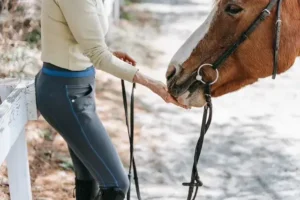If you were to read up on the history of horses, you would sadly realize that the world has indeed been cruel to these beautiful creatures.
Of these, the practice of hamstringing horses was common, especially among those sent to battle. That leads us to wonder.
Can a horse live after being hamstrung? And this is undoubtedly just one of the many questions on your mind about hamstringing horses.
So, here are some answers for you.
Can A Horse Live After Being Hamstrung?

Yes, a horse can potentially survive after being hamstrung, but the ability to do so and the quality of life afterward depends on the severity of the injury.
If the hamstring injury is minor, the horse may only need rest and exercise restriction for a few weeks. However, a hamstrung horse, specifically in the context of having the tendons in the back of the leg cut, will be significantly impaired.
While a horse can technically walk with such hamstring damage, they can be in great discomfort and may not move properly. This could cause them to trip and fall, leading to further injuries.
What Does It Mean To Hamstrung Horses?
To understand this, you first need to understand the working of the hamstring, which mainly consists of three muscles (biceps femoris, semimembranosus, and semitendinosus) located at the back of the horse’s hind legs.
These muscles help a horse with various movements like galloping, kicking, rearing, etc.
Hamstringing is the process of severing the tendons in the thighs, behind the knee, or the hind legs of a horse (or any animal as such) with the purpose of crippling it.
Must Read: How a horse’s hoof should look
What Do You Do When You Hamstring A Horse?
This practice was customary among those victorious in battle as a cruel way to weaken the horse’s military action and was often incurable.
This was mainly because back then, horses were one of the most potent instruments of battle when there were no nuclear weapons. The more horses and chariots, the higher the chances of emerging victorious in battle.
If you suspect your horse has a hamstring injury, the first thing you should do is call a veterinarian. They will ensure there are no significant tears and give medication and rest if appropriate. The fact is that hamstringing is not a common practice today, and many horse owners and trainers avoid this practice altogether.
What Happens To A Horse When It Is Hamstrung?
Injuries are common among horses, and sometimes a horse is hamstrung due to an injury, perhaps during a race or a moment of intense training.
Sadly, as you already know, this is not always true, as sometimes hamstringing results from human intervention so that the horse can no longer gallop.
This is done so that the horse can no longer go out to battle or be used in a chariot. However, they can still be made to work on farms.
What Happens When You Cut the Hamstring Of A Horse?
Hamstringing is a process where one grounds the horse’s front legs and then knocks off the elbow and knee, shocking the joints in the process and causing great pain to the horse’s leg.
What happens next is obvious. The horse is now crippled and, in some cases (due to the severity of the situation), even unable to walk.
Can A Hamstrung Horse Recover?
This depends on how severely the horse has been hamstrung. A mildly hamstrung horse will take about two weeks to recover.
However, if he is badly hamstrung, he would probably need a month of medication, therapy, and, not to forget, a lot of rest and tender loving care.
Waste no time in taking your horse to the vet, so he can look at the tear and come up with the most appropriate treatment.
And then, in some of the saddest cases, a horse can never get healed as the damage is too severe for the tendons in the horse to reunite again.
How Long Does A Hamstring Last?
A tear or two can heal within a month, but the problem arises when the horse has been badly injured or is not getting the proper rest and therapy.
Owners often need more time to return the horse to the training ground instead of ensuring its complete healing.
Now that you know this make sure you are not one of them and remember that your horse’s hamstring is most important, not the prize you are looking forward to winning.
How Painful Is A Hamstring?
This is why it is essential to protect your horse’s hamstring with regular exercise to keep it strong in the long run.
Remember that the process of hamstringing causes a significant strain on the leg muscle, and the horse goes through a great deal of pain, which is sudden and sharp, with a sensation like that of something popping or tearing.
Now, if you are a horse lover, reading up on this till now indeed is enough to break your heart.
Can A Cut Hamstring Be Repaired?
The truth is that a cut hamstring will not heal on its own and will need immediate surgery, where the vet will once again attach the tendons to the pelvic bone.
Some stitches will be involved, and while this can be painful, remember that it is the easiest and safest way to cure a horse facing a hamstring.
Has A Horse Survived A Broken Leg?
Please don’t follow anyone’s advice to euthanize it; that would be ignorant and cruel.
Don’t let an injury, however big or small, freak you out, and remember that injuries are common in a horse, like all the running and galloping it is always set to do.
And yet, don’t be an overprotective owner either, for there is nothing that a horse loves more than galloping with a rider, for that is his favorite way of bonding with a human, showing off his great strength, for horses love humans.
Recommended Reading: Do Horses Have Periods?
Final Words
So, now that you know what an injured horse can go through, keep this in mind when you are taking your horse through a training process, and do not be too intense with him.
Let the horse take time to learn, and don’t burden him with lofty expectations that can injure him and keep him from enjoying the training process.
Frequently Asked Questions
Okay, that is all about the horse and his hamstrung leg, and we hope that educates you on what you should and should not do, but here are a few last FAQs.
Q1. Can Horses Live With Three Legs?
Ans: Yes, a horse can live with three legs, like a human can live with just one leg. He won’t be able to stand up on his own and will quickly be prone to injuries which can sometimes even result in death.
Q2. Is It Cruel To Race A Horse?
Ans: Racing a horse is fine, and horses love it, but pushing your horse too hard is cruel. Do not strike him too hard with the whip; be patient in training.
Q3. What horse has the most robust legs?
Ans: The Belgian draft is one horse with the most muscular legs, but this does not mean he is not prone to hamstrings, so don’t be careless.



